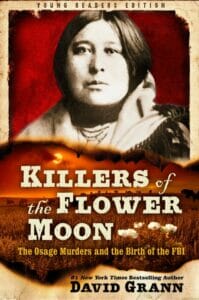Reign of Terror
By Audrey Schwartz, Adult Services Librarian II

Today’s story in crime history happens south of our border in Oklahoma—the Osage Indian murders, also known as the Osage Reign of Terror (1921-1926), lasted from 1918-1931 in Osage County, Oklahoma. But first some housekeeping. I am an Indigenous woman, so while this isn’t part of my personal history, it is part of the collective history and memories of Indigenous folk. I am Miami from the Banks of the Wabash River, and my people were removed to Miami, Oklahoma.
Back to the Osage. In 1897, oil was discovered on Osage Reservation land, and the federal government allotted over 600 acres of mineral rights to each Osage who was on the 1907 tribal rolls. In the 21 years between discovery and the first murders, the oil market had grown considerably. This rapid growth brought substantial wealth to the Osage, who were deemed, according to Grann “the richest nation, clan or social group of any race on earth, including the whites, man for man.” The majority of the murders were connected to a scheme to inherit Osage land, the mineral rights, and thusly the wealth. Few of the crimes were prosecuted, but some were convicted and sentenced. William Hale was one of the few caught and tried for ordering the murder of his nephew’s wife and other family members. After 5 years of pinpointed killing and 13 total years of incidents, the U.S. Congress changed the law to exclude non-enrolled family from inheriting the land and rights.
In 1994, Dennis McAuliffe, Jr wrote “The Deaths of Sybil Bolton,” which is the true story of how his Osage grandmother died. McAuliffe had always been told his maternal grandmother died of kidney disease in 1925, at the age of 21. McAuliffe’s curiosity, as a reporter, got the best of him. In doing further research he discovered, 66 years later, that her death was recorded as suicide. He kept digging and began using the rarely-accessed FBI files on the “Osage Reign of Terror.” As he continued to look into his grandmother’s death, he discovered the awful truth: she was shot and murdered. His grandmother had been targeted during the Osage murders for her land and mineral rights. Throughout the book, McAuliffe uses the FBI investigation files, family interviews, and help from the Osage to primarily focus his quest.
David Grann’s “Killers of the Flower Moon: The Osage Murders and the Birth of the FBI” was released in 2016. Grann’s book relies heavily on the FBI files and storytelling from tribal members to paint a story of devastating loss and betrayal. Grann’s book thoroughly follows the story, presenting evidence and explaining the connections and reasonings behind the murders. In doing this, readers are presented with this grand picture of the strategic and purposeful “phenomenon” of wealthy Osage with oil rights being murdered by their White “guardians” to take away their wealth. These “guardians” formed relationships with corrupt doctors and local politicians specifically to murder people for oil rights. In 2021, Grann released a young adult version of his award-winning tome. This version is trimmed down to be more approachable.
In 2021, Martin Scorsese began production of a movie based on Grann’s book, which is set to be released in 2023. It stars Leonardo DiCaprio, who also serves as producer is cast in the role of William Hale’s nephew alongside Robert De Niro as William Hale, Jesse Plemons, Lily Gladstone and Brendan Fraser. Scorsese traveled to the Osage Nation and spoke with Principal Chief Geoffrey Standing Bear in order to determine how the Osage would be involved in the film. He tells this story on the land it occurred on and with people who were involved. Osage members make up a mixture of the actors in the film and were, of course, used as cultural advisors.
These books and the movie serve as a reminder of the generational trauma that just one tribe experienced. They are great and accurate resources of a tragic, forgotten, and purposely-buried story and how the Osage survived and thrived through the events.

